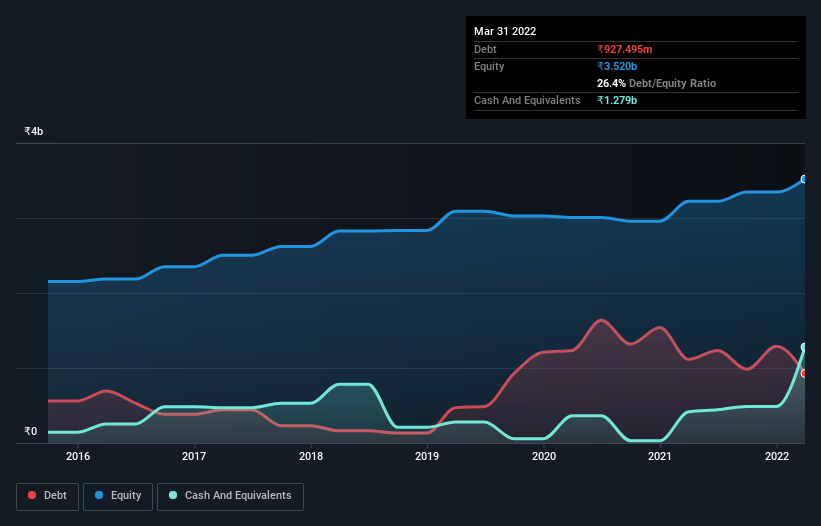- India
- /
- Auto Components
- /
- NSEI:MUNJALAU
Munjal Auto Industries (NSE:MUNJALAU) Has A Pretty Healthy Balance Sheet
Warren Buffett famously said, 'Volatility is far from synonymous with risk.' When we think about how risky a company is, we always like to look at its use of debt, since debt overload can lead to ruin. As with many other companies Munjal Auto Industries Limited (NSE:MUNJALAU) makes use of debt. But the real question is whether this debt is making the company risky.
What Risk Does Debt Bring?
Debt is a tool to help businesses grow, but if a business is incapable of paying off its lenders, then it exists at their mercy. Ultimately, if the company can't fulfill its legal obligations to repay debt, shareholders could walk away with nothing. While that is not too common, we often do see indebted companies permanently diluting shareholders because lenders force them to raise capital at a distressed price. Having said that, the most common situation is where a company manages its debt reasonably well - and to its own advantage. When we examine debt levels, we first consider both cash and debt levels, together.
View our latest analysis for Munjal Auto Industries
What Is Munjal Auto Industries's Debt?
You can click the graphic below for the historical numbers, but it shows that Munjal Auto Industries had ₹927.5m of debt in March 2022, down from ₹1.11b, one year before. However, its balance sheet shows it holds ₹1.28b in cash, so it actually has ₹351.6m net cash.

How Healthy Is Munjal Auto Industries' Balance Sheet?
Zooming in on the latest balance sheet data, we can see that Munjal Auto Industries had liabilities of ₹5.13b due within 12 months and liabilities of ₹964.8m due beyond that. On the other hand, it had cash of ₹1.28b and ₹3.88b worth of receivables due within a year. So its liabilities outweigh the sum of its cash and (near-term) receivables by ₹934.0m.
Given Munjal Auto Industries has a market capitalization of ₹5.12b, it's hard to believe these liabilities pose much threat. Having said that, it's clear that we should continue to monitor its balance sheet, lest it change for the worse. While it does have liabilities worth noting, Munjal Auto Industries also has more cash than debt, so we're pretty confident it can manage its debt safely.
Munjal Auto Industries grew its EBIT by 6.5% in the last year. That's far from incredible but it is a good thing, when it comes to paying off debt. When analysing debt levels, the balance sheet is the obvious place to start. But you can't view debt in total isolation; since Munjal Auto Industries will need earnings to service that debt. So when considering debt, it's definitely worth looking at the earnings trend. Click here for an interactive snapshot.
Finally, a company can only pay off debt with cold hard cash, not accounting profits. While Munjal Auto Industries has net cash on its balance sheet, it's still worth taking a look at its ability to convert earnings before interest and tax (EBIT) to free cash flow, to help us understand how quickly it is building (or eroding) that cash balance. Over the last three years, Munjal Auto Industries actually produced more free cash flow than EBIT. That sort of strong cash conversion gets us as excited as the crowd when the beat drops at a Daft Punk concert.
Summing Up
Although Munjal Auto Industries's balance sheet isn't particularly strong, due to the total liabilities, it is clearly positive to see that it has net cash of ₹351.6m. And it impressed us with free cash flow of ₹1.2b, being 106% of its EBIT. So we are not troubled with Munjal Auto Industries's debt use. The balance sheet is clearly the area to focus on when you are analysing debt. However, not all investment risk resides within the balance sheet - far from it. For instance, we've identified 3 warning signs for Munjal Auto Industries (1 is potentially serious) you should be aware of.
At the end of the day, it's often better to focus on companies that are free from net debt. You can access our special list of such companies (all with a track record of profit growth). It's free.
New: Manage All Your Stock Portfolios in One Place
We've created the ultimate portfolio companion for stock investors, and it's free.
• Connect an unlimited number of Portfolios and see your total in one currency
• Be alerted to new Warning Signs or Risks via email or mobile
• Track the Fair Value of your stocks
Have feedback on this article? Concerned about the content? Get in touch with us directly. Alternatively, email editorial-team (at) simplywallst.com.
This article by Simply Wall St is general in nature. We provide commentary based on historical data and analyst forecasts only using an unbiased methodology and our articles are not intended to be financial advice. It does not constitute a recommendation to buy or sell any stock, and does not take account of your objectives, or your financial situation. We aim to bring you long-term focused analysis driven by fundamental data. Note that our analysis may not factor in the latest price-sensitive company announcements or qualitative material. Simply Wall St has no position in any stocks mentioned.
About NSEI:MUNJALAU
Munjal Auto Industries
Manufactures and sells auto components for motor vehicles in India.
Low risk and slightly overvalued.
Market Insights
Community Narratives





